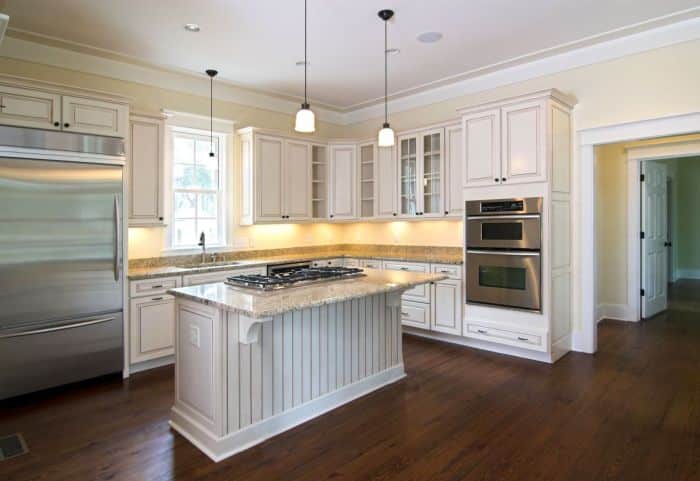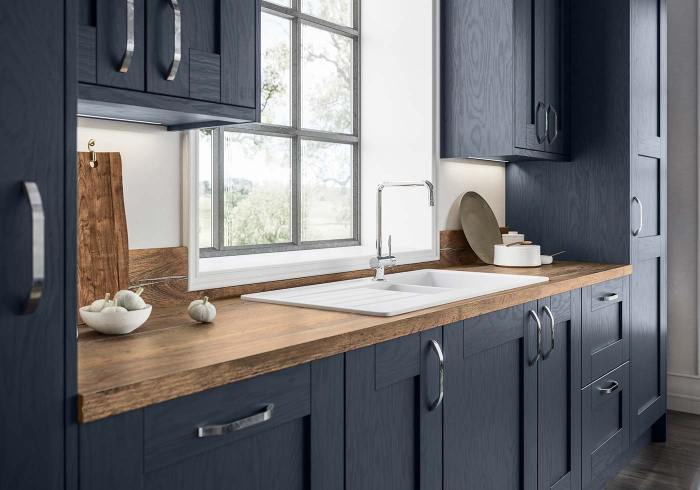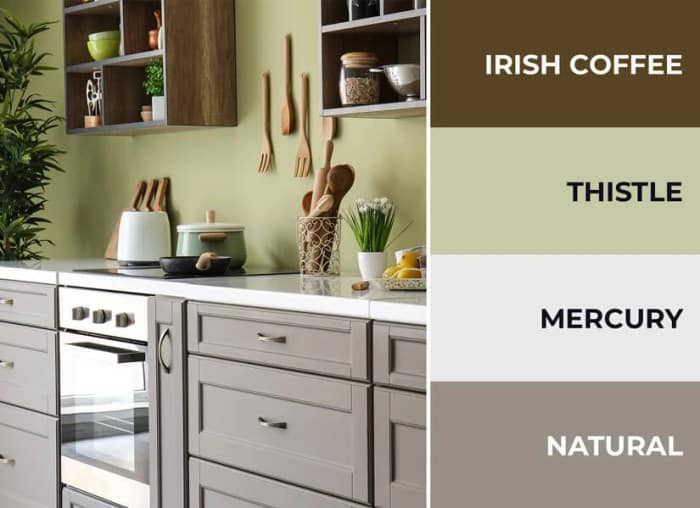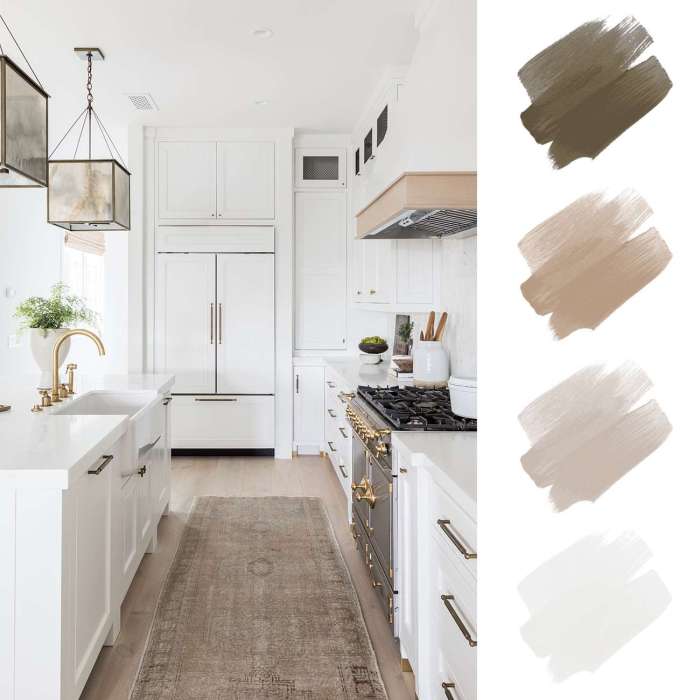The American Classic kitchen, a timeless design staple, finds renewed elegance in neutral tones. This aesthetic, characterized by its clean lines and understated sophistication, balances functionality with enduring style. By carefully selecting materials, from cabinetry and countertops to flooring and lighting, a neutral palette creates a versatile backdrop that can be customized to reflect personal preferences, ranging from rustic charm to modern minimalism.
The key lies in understanding the interplay of color, texture, and material choice to achieve a harmonious and inviting space.
This exploration delves into the core principles of designing a neutral-toned American Classic kitchen. We will examine the various elements – cabinetry styles, countertop materials, backsplash options, appliance selections, flooring choices, and lighting schemes – that contribute to the overall aesthetic. We’ll analyze the impact of different material combinations and design choices on the kitchen’s atmosphere, providing practical guidance and illustrative examples to inspire your own design journey.
Defining “Neutral Tone American Classic Kitchen”
The neutral-toned American Classic kitchen represents a timeless aesthetic, prioritizing functionality and clean lines while embracing a sense of understated elegance. It avoids bold colors and dramatic patterns, instead focusing on a palette that promotes a feeling of calm and spaciousness. This style draws inspiration from traditional American kitchens but modernizes them with updated materials and a focus on simplicity.The core aesthetic elements of this design revolve around a balance between classic architectural details and contemporary minimalism.
The emphasis is on creating a kitchen that is both visually appealing and highly functional, suitable for everyday use and capable of withstanding the test of time. The overall effect is one of refined simplicity, creating a space that is both inviting and sophisticated.
Color Palettes
Neutral color palettes in American Classic kitchens typically center around variations of white, beige, gray, and cream. These foundational hues provide a versatile backdrop that can be easily accented with subtle pops of color through accessories, backsplashes, or hardware. For instance, a creamy white cabinetry might be paired with light gray countertops and a white subway tile backsplash, creating a harmonious and sophisticated look.
Variations include warmer palettes incorporating soft tans and greige tones, offering a cozier ambiance. Cooler palettes might utilize shades of light gray and white, evoking a more modern and airy feel. These palettes are chosen for their ability to maximize natural light and create a sense of spaciousness, crucial in many American home designs.
Materials Selection
Cabinetry in a neutral-toned American Classic kitchen commonly features wood in shades of white, off-white, or light-toned natural wood finishes. Materials such as painted wood, maple, or shaker-style cabinets are frequently employed. These materials are chosen for their durability, classic appeal, and ability to integrate seamlessly with the overall neutral color scheme. Countertops often incorporate materials such as quartz, granite, or marble in light neutral tones that complement the cabinetry.
These materials offer both aesthetic appeal and practical functionality, providing durability and easy maintenance. Flooring frequently features hardwood in light colors, porcelain tile mimicking hardwood, or even large-format neutral-toned ceramic tiles. These choices provide a durable and easy-to-clean surface while maintaining the overall aesthetic harmony of the kitchen. The selection of these materials emphasizes both practicality and timeless style.
Cabinetry and Hardware

The selection of cabinetry and hardware is paramount in establishing the aesthetic and functionality of a neutral-toned American classic kitchen. These elements work in concert to define the space’s character, blending seamlessly with the overall design scheme while contributing to the kitchen’s enduring appeal. The careful consideration of both form and function ensures a kitchen that is both beautiful and practical.Cabinetry styles, materials, and colors directly influence the kitchen’s visual impact, while hardware choices add the finishing touches, enhancing the overall design narrative.
The interplay between these elements creates a cohesive and harmonious environment.
Cabinetry Styles and Materials
The following table presents three distinct cabinetry styles suitable for a neutral-toned American classic kitchen, outlining their material and color options, along with appropriate hardware choices. These styles represent a range of visual textures and aesthetic approaches, allowing for diverse design interpretations within the overall neutral palette.
| Style | Material | Color | Hardware |
|---|---|---|---|
| Shaker | Solid wood (maple, oak, cherry) | White, off-white, light gray, beige | Brushed nickel, oil-rubbed bronze |
| Raised-Panel | Solid wood (oak, hickory), painted wood | Cream, soft gray, ivory | Polished nickel, antique brass |
| Flat-Panel | Thermofoil, painted MDF, lacquered wood | White, light gray, taupe | Brushed nickel, polished chrome |
Shaker, Raised-Panel, and Flat-Panel Cabinet Doors
Shaker-style cabinet doors are characterized by their simple, flat central panel framed by a recessed rectangular border. This minimalist design lends itself to a clean, uncluttered aesthetic, aligning well with the principles of American classic design. Raised-panel doors feature a central panel raised above the surrounding frame, creating a more ornate and traditional look. This style adds visual depth and texture, suitable for kitchens aiming for a more formal or detailed appearance.
Flat-panel doors, on the other hand, present a completely flat surface, offering a modern, sleek alternative within the classic design framework. The choice between these styles influences the overall level of detail and visual complexity within the kitchen. The inherent simplicity of shaker cabinets contrasts with the more pronounced detailing of raised panel cabinets. Flat panel cabinets provide a clean, contemporary feel that can still work within a classic aesthetic, particularly when paired with appropriate hardware.
Hardware Finishes and Their Aesthetic Impact
Hardware finishes play a crucial role in establishing the overall mood and character of the kitchen. Brushed nickel offers a subtle, understated elegance, blending seamlessly with various color palettes. Its slightly textured surface adds a touch of warmth and sophistication. Oil-rubbed bronze imparts a richer, more antique feel, lending itself to a more traditional or rustic aesthetic. Its dark, aged tone provides a strong contrast against lighter cabinetry.
Polished chrome, conversely, provides a sleek, modern contrast, reflecting light and creating a sense of brightness and spaciousness. The choice of finish significantly impacts the visual weight and perceived temperature of the kitchen, with warmer finishes like oil-rubbed bronze creating a cozier atmosphere, while cooler finishes like polished chrome contribute to a more airy and contemporary feel. The interplay between the hardware finish and the cabinetry color is key to achieving a balanced and harmonious design.
For example, brushed nickel hardware complements white or light gray cabinets beautifully, while oil-rubbed bronze enhances the warmth of cream or beige cabinets.
Countertops and Backsplashes
The selection of countertops and backsplashes significantly impacts the aesthetic and functionality of an American Classic kitchen, particularly within a neutral tone palette. These surfaces offer opportunities to introduce subtle texture and visual interest while maintaining the overall calm and timeless feel desired in this style. The interplay between countertop material, color, and backsplash design determines the final atmosphere, ranging from understated elegance to a more vibrant, yet still classic, expression.
The choice of countertop material is paramount. Durability, maintenance requirements, and aesthetic compatibility with the overall neutral scheme are key considerations. The backsplash, acting as a visual transition between the countertop and upper cabinets, offers further opportunities for stylistic expression and practical protection.
Countertop Material Selection for Neutral Tone American Classic Kitchens
Several materials are commonly employed in American Classic kitchens, each possessing unique properties that align differently with a neutral color scheme. The following Artikels the advantages and disadvantages of popular choices:
- Quartz: A manufactured stone, quartz offers exceptional durability, stain resistance, and low maintenance. Its consistent color and pattern make it an ideal choice for a neutral palette, allowing for subtle veining or a completely uniform appearance. However, it can be more expensive than other options and may lack the natural variation found in stone.
- Granite: A natural stone, granite boasts unique veining and color variations. While some granites feature neutral tones, others may have bolder colors that might clash with a neutral scheme. It’s highly durable but requires sealing to protect against staining. The natural variations can be a pro or con, depending on the desired aesthetic.
- Marble: Another natural stone, marble is known for its elegance and luxurious veining. However, it is more porous than granite or quartz, making it susceptible to staining and etching. While some marbles offer neutral tones, many feature prominent veining that may not suit a minimalist neutral scheme. It requires regular sealing and careful maintenance.
- Butcher Block: Offering a warm, rustic charm, butcher block countertops provide a unique texture and visual appeal. While not strictly a neutral material itself, its natural wood tones can complement a neutral color scheme, especially when paired with lighter-colored cabinetry. It requires regular oiling to maintain its integrity and is susceptible to water damage if not properly cared for.
Backsplash Design Options for Neutral Tone American Classic Kitchens
The backsplash provides a canvas for subtle pattern and texture, enhancing the overall kitchen design. Three distinct options, each contributing a unique visual effect, are presented below:
- Subway Tile in a Neutral Color: Classic white or light gray subway tiles create a timeless and clean look. The simple rectangular shape and consistent color maintain a sense of calm and order, perfectly complementing a neutral countertop. This option offers a versatile backdrop that won’t overpower the other elements in the kitchen. The visual effect is one of understated elegance and refined simplicity.
- Large-Format Calacatta Marble Tiles: Large, rectangular Calacatta marble tiles introduce subtle veining and movement to the backsplash without being overwhelming. The neutral color palette of the marble, often featuring creamy whites and gray veining, harmonizes beautifully with a neutral countertop. This choice adds a touch of understated luxury and visual interest. The effect is one of sophisticated simplicity and quiet elegance.
- Small Mosaic Tiles in a Neutral Tone with Subtle Metallic Accents: A mosaic backsplash composed of small, neutral-toned tiles with interspersed metallic accents (such as brushed nickel or gold) adds a touch of visual intrigue. The variety of textures and the subtle shimmer of the metallic elements create a visually richer experience without overpowering the overall neutral scheme. This option brings a sense of subtle dynamism and visual texture to the space.
The effect is one of quiet sophistication and understated luxury.
Impact of Countertop and Backsplash Choices on Kitchen Feel
The careful selection of countertops and backsplashes significantly influences the overall feel of the kitchen. For instance, a quartz countertop with white subway tiles creates a clean, modern, yet classic feel. Conversely, a marble countertop with large-format marble tiles leans towards a more traditional, luxurious aesthetic. The use of butcher block countertops, paired with a mosaic backsplash, might yield a more rustic and warm ambiance.
The combination of materials and patterns allows for a wide range of stylistic expressions, all within the framework of a neutral-toned American Classic kitchen.
Appliances and Fixtures
The selection of appliances and fixtures is crucial in achieving a cohesive and functional neutral-toned American classic kitchen. These elements, while seemingly minor, significantly impact the overall aesthetic and usability of the space. The key is to balance timeless elegance with modern functionality, maintaining a consistent color palette and material choices to avoid visual dissonance.The careful consideration of appliance finishes, faucet styles, and lighting fixtures contributes to the overall harmony and sophistication of the design.
Matching these elements to the existing color scheme and cabinetry creates a unified and visually appealing kitchen.
Appliance Styles and Finishes
Stainless steel appliances remain a popular and versatile choice for neutral-toned kitchens. Their sleek, modern aesthetic complements the classic design without overpowering it. However, other finishes can equally enhance the design. White appliances, for instance, offer a clean and timeless look, echoing the traditional aesthetic. Black stainless steel appliances, while a more recent trend, provide a sophisticated contrast against lighter cabinetry and countertops.
The choice ultimately depends on the specific shade of neutral tones used in the kitchen. A warm, creamy neutral might pair better with white appliances, while a cooler gray might be enhanced by stainless steel or black stainless steel. Consider also the scale of the appliances; larger, professional-grade appliances can make a statement while maintaining a classic feel if their finishes and styling align with the overall theme.
Kitchen Faucet Features
A kitchen faucet in a neutral-toned American classic kitchen should be both functional and aesthetically pleasing. A gooseneck faucet, for instance, is a classic style that provides ample clearance for filling pots and cleaning dishes. Materials such as brushed nickel or polished chrome offer durability and complement the neutral palette. Features such as a pull-down sprayer provide added convenience without compromising the overall aesthetic.
Furthermore, a high-arc faucet can add elegance while maintaining practicality. The handle style is also important; lever handles are modern and easy to use, while cross handles offer a more traditional look. The choice should be guided by the overall design theme; a highly modern faucet might clash with the classic feel, while a too-rustic faucet could feel out of place.
Lighting Fixtures
Appropriate lighting is essential for both functionality and ambiance in any kitchen. Recessed lighting provides even, general illumination, perfect for task lighting over countertops and work areas. Pendant lights above the island or kitchen table add a touch of elegance and focused illumination for specific areas. The style of pendant lights should complement the cabinetry and hardware; for example, simple, cylindrical pendants would suit a minimalist classic design, while more ornate pendants could enhance a more traditional style.
Under-cabinet lighting is also crucial for task illumination, offering convenient light for food preparation. Warm-toned LED bulbs in all fixtures contribute to a welcoming and inviting atmosphere, while maintaining energy efficiency. The placement of lighting fixtures should be carefully planned to avoid harsh shadows and ensure adequate lighting for all kitchen activities. Consider dimmer switches to allow for adjustable light levels to suit various moods and activities.
Flooring and Lighting

The selection of flooring and lighting significantly impacts the aesthetic and functional aspects of a neutral-toned American classic kitchen. Appropriate choices enhance the space’s overall ambiance, creating a cohesive and inviting atmosphere. Careful consideration of material properties, color palettes, and lighting schemes is crucial for achieving the desired effect.Flooring Material Selection for a Neutral American Classic KitchenThe choice of flooring material significantly influences the kitchen’s visual appeal and durability.
Several options align well with the neutral color palette of a classic American kitchen design. The optimal selection depends on factors such as budget, maintenance requirements, and personal preference.
Hardwood Flooring Options
Hardwood flooring offers a timeless elegance, well-suited to the classic American kitchen style. Neutral tones like light oak, warm maple, or even a subtly grayed-out hickory provide a versatile backdrop. The natural grain and variations in color add character and texture, enhancing the overall warmth. Hardwood is relatively durable, though it requires regular maintenance such as sweeping, occasional mopping, and periodic refinishing to maintain its appearance.
Tile Flooring Options
Ceramic or porcelain tiles in neutral colors such as off-white, light gray, or beige provide a practical and stylish alternative to hardwood. These materials are highly durable, resistant to water damage, and relatively easy to clean, making them ideal for a high-traffic area like a kitchen. Large format tiles can create a sense of spaciousness, while smaller tiles offer more design flexibility, allowing for patterns or borders that complement the overall aesthetic.
Consider textured tiles for added visual interest and to mitigate slipperiness.
Vinyl Flooring Options
Luxury vinyl plank (LVP) or luxury vinyl tile (LVT) flooring offers a budget-friendly and durable option that mimics the appearance of hardwood or stone. Modern LVP/LVT options come in a wide range of neutral colors and textures, making it easy to find a style that complements a classic American kitchen. These materials are waterproof, resistant to scratches and dents, and relatively easy to maintain, making them a practical choice for busy kitchens.
Lighting Schemes for a Neutral-Toned American Classic Kitchen
Lighting plays a vital role in setting the mood and functionality of a kitchen. A well-designed lighting plan incorporates a layered approach, combining ambient, task, and accent lighting to achieve optimal illumination and atmosphere.
Lighting Scheme Examples
The following table Artikels three distinct lighting schemes suitable for a neutral-toned American classic kitchen, highlighting the mood each creates. The light temperature is measured in Kelvin (K); lower Kelvin values indicate warmer light, while higher values indicate cooler light.
| Lighting Type | Placement | Light Temperature (K) | Mood |
|---|---|---|---|
| Ambient Lighting | Recessed lighting throughout the ceiling, possibly supplemented by a central pendant light fixture | 2700-3000 | Warm and inviting, creating a comfortable and relaxed atmosphere. |
| Task Lighting | Under-cabinet lighting, pendant lights above islands or peninsulas, and adjustable spotlights over work areas | 3000-4000 | Functional and bright, ensuring adequate illumination for food preparation and cleaning tasks. |
| Accent Lighting | Track lighting to highlight architectural details, open shelving, or display cabinets; decorative sconces to add a touch of elegance | 2700-3000 | Adds visual interest and depth, enhancing the overall aesthetic appeal of the kitchen. |
Impact of Flooring on Space and Light
Different flooring materials affect the perception of space and light in a kitchen. Light-colored flooring, such as light oak hardwood or off-white tile, reflects light, making the kitchen appear larger and brighter. Conversely, darker flooring materials absorb light, creating a cozier, more intimate feel, but potentially making the space seem smaller. Highly reflective materials such as polished porcelain tiles can further enhance the brightness and spaciousness of the kitchen.
The texture of the flooring also plays a role; smooth surfaces reflect more light than textured ones. For example, a highly polished marble floor will create a significantly brighter kitchen compared to a kitchen with a rustic, textured tile floor.
Illustrative Examples

The following examples demonstrate the versatility of the neutral-toned American classic kitchen design, showcasing how different material choices and color palettes can create distinct atmospheres while maintaining a cohesive aesthetic. These examples highlight the interplay of light and shadow, texture and form, to achieve visually appealing and functionally efficient spaces.
White Shaker Cabinets, Quartz Countertops, and Subway Tile Backsplash
This design exemplifies the quintessential American classic kitchen. The bright white shaker cabinets, a timeless choice, maximize light reflection, creating an airy and spacious feel, even in smaller kitchens. The clean lines of the shaker style contribute to a sense of order and simplicity. The quartz countertops, known for their durability and resistance to staining, offer a practical and elegant surface.
Their subtle veining adds visual interest without overwhelming the overall neutral palette. The classic subway tile backsplash, in a neutral white or light gray, provides a textural contrast and a timeless backdrop for the kitchen’s functionality. The overall atmosphere is one of calm, cleanliness, and timeless elegance. The bright, reflective surfaces enhance the sense of spaciousness, making the kitchen feel inviting and welcoming.
Dark Hardwood Floors, Dark-Stained Cabinetry, and Light-Colored Countertops
This example showcases the power of contrast. The dark hardwood floors, often chosen for their durability and richness, ground the space and add warmth. The dark-stained cabinetry creates a sense of sophistication and depth. This darker palette is balanced by the incorporation of light-colored countertops, such as a creamy white marble or a light-colored quartz. This contrast prevents the kitchen from feeling too heavy or closed in.
The light countertops also serve as a practical element, providing a stark visual contrast against darker elements and preventing spills and stains from being as noticeable. The overall effect is a balanced and sophisticated design, blending warmth and modernity. The interplay between light and dark creates visual interest and depth, preventing monotony.
Marble Countertops and Stainless Steel Appliances with Light-Colored Cabinetry
This design combines luxurious materials with a clean, modern aesthetic. The light-colored cabinetry, perhaps in a creamy white or a soft gray, provides a neutral backdrop that allows the other elements to shine. The marble countertops, with their inherent veining and unique patterns, introduce a touch of natural elegance and sophistication. The cool tones of the marble complement the stainless steel appliances, which are chosen for their functionality and modern appeal.
The stainless steel provides a reflective surface, adding to the overall brightness of the kitchen. The combination of natural stone and sleek, modern appliances creates a design that is both elegant and practical. The interplay of textures – the smooth marble, the brushed steel, and the slightly textured cabinetry – adds depth and visual interest to the space.
Wrap-Up

Designing a neutral-toned American Classic kitchen is a journey of thoughtful selection and considered balance. The inherent versatility of a neutral palette allows for remarkable flexibility, accommodating diverse personal styles and preferences. From the subtle interplay of light and shadow created by carefully chosen materials to the strategic placement of lighting fixtures, each design element contributes to the overall ambiance.
The result is a kitchen that transcends fleeting trends, offering a timeless and enduring space for culinary creativity and comfortable gatherings. Whether embracing a minimalist aesthetic or incorporating elements of rustic charm, the principles Artikeld here provide a foundation for crafting a kitchen that is both beautiful and functional.
FAQ Corner
What are some popular neutral color palettes for an American Classic kitchen?
Popular neutral palettes include variations of white and cream, greige (a blend of gray and beige), soft grays, and warm whites. These can be accented with subtle hints of black, navy, or muted greens for added depth.
How can I make a neutral kitchen feel warmer?
Incorporate warm-toned wood flooring, warmer white paint colors with undertones of cream or beige, brass or warm gold hardware, and warm-toned lighting (2700-3000K).
What are some budget-friendly countertop options for a neutral kitchen?
Laminate countertops offer a cost-effective solution that can mimic the look of more expensive materials like granite or marble. Engineered quartz is another mid-range option that provides durability and a wide range of neutral colors.
How do I choose the right lighting for a neutral kitchen?
Layer lighting using a combination of ambient, task, and accent lighting. Recessed lighting provides general illumination, while pendant lights over the island offer task lighting. Under-cabinet lighting illuminates work surfaces. Accent lighting can highlight architectural features or artwork.
Can I mix different materials in a neutral kitchen?
Absolutely! Mixing materials like wood, stone, and metal adds visual interest and texture. For example, pairing marble countertops with wood cabinetry creates a sophisticated and inviting atmosphere.
